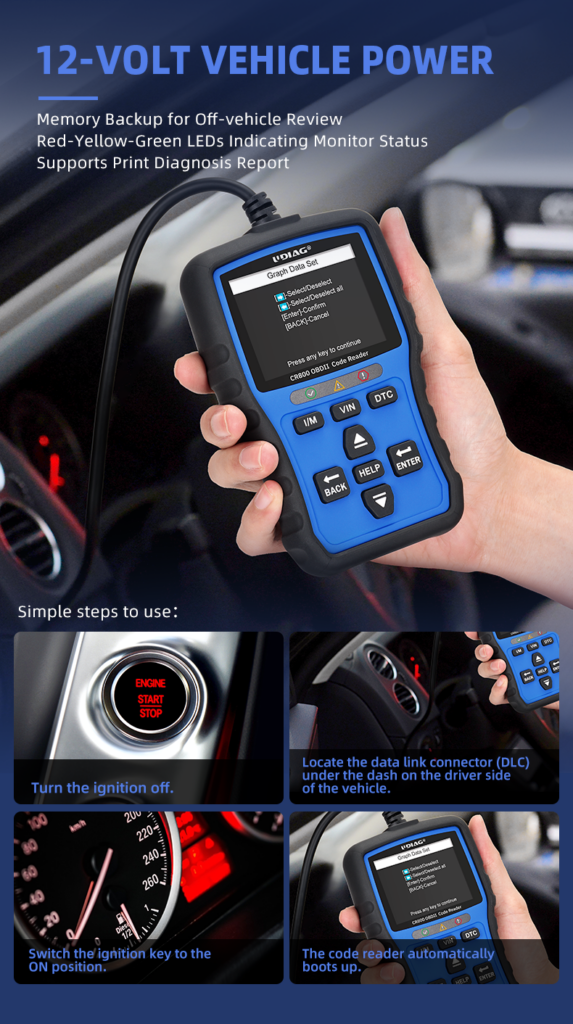Do OBDII Code Reader work when an engine won’t start?
2024-01-04 by UDIAG
In the realm of automotive diagnostics, On-Board Diagnostics II (OBDII) Code Readers have become indispensable tools for identifying and resolving engine issues. These devices provide valuable insights by reading diagnostic trouble codes (DTCs) and accessing real-time data. However, a common question arises: Can OBDII Code Readers work when an engine won’t start? This essay aims to explore the functionalities of OBDII Code Readers, their limitations, and their effectiveness in diagnosing engine no-start situations.

I. Understanding OBDII Code Readers
OBDII, the second generation of On-Board Diagnostics systems, is a standardized protocol that enables communication between a vehicle’s onboard computer and external diagnostic tools. OBDII Code Readers play a crucial role in this system, offering capabilities such as reading DTCs, accessing real-time data, and providing emissions readiness status.
II. Limitations of OBDII Code Readers
While OBDII Code Readers are powerful tools, they have limitations. Their effectiveness depends on vehicle compatibility, requiring a standardized OBDII port. Additionally, they need power and communication with the vehicle, making them dependent on the overall electrical system. Furthermore, OBDII Code Readers may not be capable of diagnosing non-electronic or mechanical issues.
III. OBDII Code Readers and Engine No-Start Situations
Engine no-start situations can result from various issues, ranging from electrical failures to mechanical problems. Despite these challenges, OBDII Code Readers can still offer valuable insights. They can access historical DTCs, check for communication issues, and monitor sensors and data during attempted starts.
IV. Troubleshooting with OBDII Code Readers
When facing a no-start scenario, a systematic approach with an OBDII Code Reader can be beneficial. Steps include checking for power and connectivity issues, analyzing relevant data, and interpreting DTCs. The device becomes a valuable aid in narrowing down potential causes and guiding further diagnostics.
V. When OBDII Code Readers may not be effective
It’s essential to acknowledge situations where OBDII Code Readers might not be as effective. Mechanical failures that OBDII cannot detect and severe electrical issues preventing communication are instances where these tools may fall short. In such cases, professional diagnostics become imperative for a comprehensive assessment.
Conclusion
In conclusion, OBDII Code Readers play a crucial role in diagnosing engine issues, even in no-start situations. Their ability to access historical data, check for communication issues, and monitor sensors can provide valuable insights. However, it’s equally important to recognize their limitations, especially in cases of mechanical failures or severe electrical issues. A holistic approach to troubleshooting engine problems, combining OBDII Code Readers with professional diagnostics, ensures a thorough and accurate assessment.
FAQs
1. Can an OBDII Code Reader diagnose engine issues when the vehicle won’t start?
OBDII Code Readers can still provide valuable information in a no-start situation by accessing historical trouble codes and monitoring relevant data during attempted starts.
2. What are the main functions of OBDII Code Readers?
OBDII Code Readers can read diagnostic trouble codes (DTCs), access real-time data, and provide emissions readiness status for a vehicle.
3. Are OBDII Code Readers compatible with all vehicles?
OBDII Code Readers require a standardized OBDII port for compatibility, and not all vehicles may have this feature.
4. Can OBDII Code Readers diagnose mechanical issues causing a no-start condition?
OBDII Code Readers are limited to electronic and sensor-related diagnostics and may not be effective in identifying mechanical failures.
5. How do OBDII Code Readers help in troubleshooting engine no-start situations?
OBDII Code Readers can assist by checking for historical DTCs, monitoring sensor data during start attempts, and identifying communication issues.


